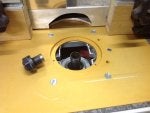Found the photos.
I had previously done this on a Makita, but wanted it back for handheld use - easy to reverse the modification.
This time, I did it on a Chinese 1900W router. The first photo shows the base of the router - you can see the roll pin inside the column. I cut the pins with a fine junior hacksaw blade and forced them apart. The spring and a follower, were inside one of the columns. The other column, in this particular router (but not the Makita), housed a fine depth adjustment control (red-topped shaft in 4th photo). I used that column for the allen head bolt, as it already had an opening on the top of the case - in your Ryobi, you would have to drill a hole (not if still under warranty!).
The second photo shows the allen head bolt, with a welded-on section of threaded rod, to achieve the needed length. Not ideal, as here acme threaded rods cost the earth, and acme nuts are even worse. I believe that, for a lot of money, one can get aviation bolts in long lengths. You will notice two washers, to provide a relatively low-friction bearing between the bottom of the allen head, and the cut bits of the spring roll (which are tapped back in, without binding the bolt).
The 3rd photo shows the long bolt inserted into the5 column. 5th photo shows a coupling nut screwd onto the top of the long bolt, with the router at full extension. I welded a lug onto the coupling nut, taking advantage of an existing bolt hole, to stop the nut rotating with the bolt.
6th phot shows a cap nut on the bolt - to stop overenthusiastic lowering of the router in the table.
The remaining photos show the router mounted in its plate (with a hole drilled to access the allen head bolt), above table height adjustment with a cordless drill, and the extent to which the router can be raised, once the springs have been removed. This router has a shaft lock, which can be reached under the table without much difficulty. I prefer the router plate screwed down, but if necessary, the table top is hinged to the frame, and is supported by gas struts if I want to raise it.
I put a piece of hex rod into the dial knob of an old radio, for fine adjustment. Because there is some backlash in the thread and bolt, I try to raise just below the needed height with the drill, then sneak up on the correct height with the knob. I can still use the column lock of the router, when it 9is at the correct height.
What I still need to do, is to rotate the router plate by 90 degrees, so that the access hole is at the front, leaving the fence undisturbed. Then I will try to move the router speed control and readout, to the front of the table - maybe.





























